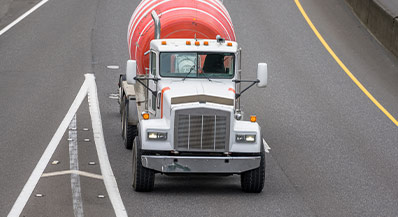Lytx Shares New Insights on Risky Driving Trends Among Concrete Fleets

- Lytx concrete clients significantly reduced occurrences of unsafe following distance* from 2018 to 2019
- Drivers of concrete vehicles were observed not wearing their seatbelts more than drivers in any other industry
SAN DIEGO — April 28, 2020 — From its unmatched database of 302,000 risky driving events captured from concrete fleets in 2019, Lytx® today released new insights into concrete-industry driving trends.
Lytx’s findings include the five risky behaviors seen most often among drivers of concrete vehicles, the most improved driving behaviors, and insights on how concrete-industry driving habits compare to those in other industries.
This data was captured from fleets of all sizes and types within the concrete industry, including those in ready mix, aggregate, concrete supply, rock, and asphalt. It is part of an ongoing series from Lytx highlighting key behavior trends seen across the nine industries that utilize Lytx video telematics technology. The data will be released twice weekly through May 19 here: https://www.lytx.com/en-us/industry-benchmark-data.
Most Prevalent Risky Behaviors in 2019
- Driver unbelted
- Smoking
- Incomplete stop
- Cell phone/device observed
- Food/drink observed
Most Improved Behaviors From 2018 to 2019
- Following distance* – improved 46%
- Smoking – improved 12%
- Incomplete stop – improved 10%
- Late response** – improved 10%
How Concrete Fleets Stack Up Against Other Industries
Lytx compared the prevalence of behaviors seen in concrete fleets against behavior averages of fleets across all its other protected industries. Comparatively, concrete fleets stood out in the following areas:
- Following distance* occurred 27% less often
- Driver unbelted, which occurred 58% more often
- Food/drink, which was observed 38% more often
Concrete Collision Insight
Lytx also found that 13.9% of collisions in the concrete segment were high or medium impact, and identified drivers driving “too fast for conditions”*** as the leading cause of high-impact crashes in the segment.
About the Data
These insights were derived from Lytx’s proprietary database of concrete driving data from 2019, including 302,000 risky concrete driving events captured last year. For comparisons across industries, Lytx calculated behavior averages from its global database, which contains driving data from construction, trucking, distribution, utilities, services, transit, government, and waste industries. Lytx maintains the fastest-growing proprietary database of professional driving data in the world, currently surpassing 120 billion miles of driving data. The data is anonymized, normalized, and in instances of behavior prevalence, generalizable to concrete fleets at large.
About Lytx
Lytx® is a leading provider of video telematics, analytics, safety, and productivity solutions for commercial, public sector, and field services fleets. Our unrivaled Driver Safety Program, powered by our best-in-class DriveCam® Event Recorder, is proven to help save lives and reduce risk. We harness the power of video to help clients see what happened in the past, manage their operations more efficiently in the present, and improve driver behavior to change the future. Our customizable services and programs span driver safety, risk detection, fleet tracking, compliance, and fuel management. Using the world’s largest driving database of its kind, along with proprietary machine vision and artificial intelligence technology, we help protect and connect thousands of fleets and more than 1.3 million drivers worldwide. For more information on Lytx telematics system, visit http://www.lytx.com, @lytx on Twitter, LinkedIn, our Facebook page, or our YouTube channel.
*Following distance refers to a risky driving event in which the distance to the vehicle directly ahead is approximately 1.5 seconds and not increasing for at least 4 consecutive seconds.
**Late response occurs when a driver is not distracted yet responds late and abruptly to a readily visible risky situation ahead.
***Too fast for conditions occurs when a vehicle seems to be traveling at a speed greater than reasonable for the given conditions. The driver may not exceed the posted speed limit but may be driving too fast for the environment. Environmental considerations include dense traffic conditions, heavy pedestrian activity, inclement weather, icy or wet road conditions, construction zones, narrow pathways, and poor visibility.
# # #
